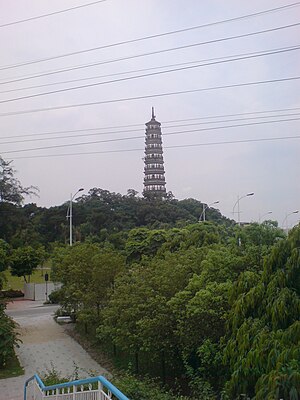Whampoa Pagoda
| Pazhou Pagoda | |||||||||||
 |
|||||||||||
| Chinese | |||||||||||
|---|---|---|---|---|---|---|---|---|---|---|---|
|
|||||||||||
| Transcriptions | |
|---|---|
| Standard Mandarin | |
| Hanyu Pinyin | Pázhōutǎ |
| Yue: Cantonese | |
| Jyutping | Paa⁴-zau¹ Taap³ |
The Pazhou Pagoda, formerly also known as the Whampoa Pagoda to Europeans, is an ancient Chinese pagoda on Pazhou Island in Haizhu District, Guangzhou, the capital of China's Guangdong Province.
The Pazhou Pagoda initiated work in 1597 and it was completely built in 1600. The pagoda is situated on a knoll at the south bank of Pearl River. Although it was built as a Buddhist landmark, it was also a useful navigation point for merchant ship travelling to Guangzhou.
It is an octagonal tower with 9 main sections and 17 sub sections. The tower stands at about 59 meters (194 ft) and has a diameter at the base of 12.7 meters (42 ft). It covers a total area of 111 square metres.
As similar functions to Chigang Pagoda, it was built for Fengshui and allow safe navigation of merchant ships travelling along the Pearl River towards Guangzhou.
Coordinates: 23°05′57″N 113°22′36″E / 23.099071°N 113.376736°E
...
Wikipedia
